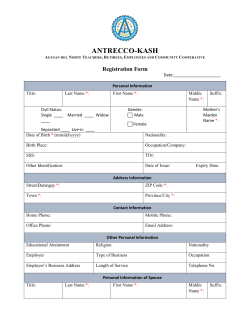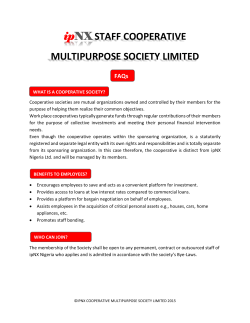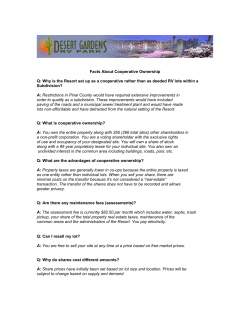
Paper presented at the 1st International Conference
Paper presented at the 1st International Conference on Applied Ergonomics ICAE 1996, Human Aspects at Work, Istanbul, Turkey, May 21st to May 24th, 1996 Task-related factors of stress: the analysis of conflict resolution in Air Traffic Control Anna Bellorini1 1 European Commission, Joint Research Centre, Ispra (Va), Italy A field study in Air Traffic Control (ATC) was performed to analyse the task-related factors of stress and how these factors can have an impact on communication, cooperation and task distribution between controllers. The field study was based on data collection, data transcription and data analysis. The management of cooperation and communication and their alterations were studied during conflict resolution. A similar resolution pattern was found in different situations, different controllers related to high self-stress evaluation. INTRODUCTION Communication is the process by which operators achieve a common understanding of the overall situation being controlled and of their respective intentions and mental pictures (Krauss et al., 1990). Controlling air traffic is managing events in real time. There are inevitably contingent factors, conflicts, increases in the traffic flow, special flights, technical troubles of various kinds, depending on the ongoing configuration of aircraft in controlled airspace that could challenge security. In a wide range of fatal or near fatal aviation accidents the language misunderstandings or omissions or communication confusion have played a contributing or even a central role (Cushing, 1994). The importance of studying communication is moreover testified by the necessity to make ATC communication more efficient and to extend the exchange of data between ATC computers by applying common specifications and by installing new equipment for the automatic data communication between ATC centres (Paulson, 1991). This paper describes the results from a field study in ATC on the analysis of the factors of stress and of their impact on the mechanisms of information transfer in a cooperative working environment. This objective is achieved through the analysis of the communication process, in particular of the flows of information between controllers and of the determination of the level of stress of these controllers. FIELD STUDY The field study, conducted at an Italian airport, analysed the activities of Air Traffic Control Operators (ATCOs) related to the Approach Control working position. The Approach Control consists of two working positions (the North sector and the South sector) in charge of a large amount of landing and taking off traffic. The field study involved the data collection, transcription and analysis. Data collection Data collection was performed following the approach of Ethnomethodology (Garfinkel, 1967) during periods of high traffic density. The data collection consisted of: (a) observations, in the control room, of the situation controlled by the South Radar Controllers (SRCs); (b) video-recordings of the SRC in order to record face-to-face communications with North Radar Controller (NRC), radar interactions and strip manipulations; (c) audio-recordings of the distance communications between SRCs, Pilots, ATCOs and Tower Controllers; (d) self-confrontation against video-recordings that includes the explanations on the activities and strategies of the SRCs; (e) the evaluation of stress using a subjective rating scale of stress during the self-confrontation. Data transcription and data analysis All the communications are transcribed using Mac Shapa (Sanderson, 1995). The transcription covers face-to-face and distance communications, SRCs explanations and comments about their strategies (self-confrontation), and the rating scale of stress of the SRCs. An Exploratory Sequential Data Analysis (Sanderson, 1995) was applied to analyse the recorded data. This analysis consisted of: (a) a video analysis to extrapolate cooperative situations between SRCs and NRCs; (b) a stress-based analysis (Bellorini et al., 1994); and (c) a communication flow analysis and a self-confrontation analysis. TASK-RELATED FACTORS OF STRESS What are the effects of stress on communication and cooperation? Is there a connection between the high self stress evaluation and any pattern of communication and cooperation? The cooperation between NRC and SRC is related to the distributed decision making of the landing order of the aircraft from North and South to the airport situated in the North sector. Figure 1 displays the evolution over the time of stress of three different SRCs measured on a subjective rating scale where, related to the peaks of stress, an effect on cooperation and communication is observed. Figure 1. Subjective rating scale of stress of three ATCOs In relation to a peak greater than 5 of the subjective evaluation of stress, the following task-related factors have been observed: (a) high density of communication and in particular overlapped communication; (b) high traffic conditions in terms of complexity, volume or holding; (c) the appearance of unexpected situations or conflicts. The main effect of these conditions is an unsuccessful cooperation because of lack of time to dedicate to explicit communication and negotiation between controllers. The time available for diagnostic process and for tactical solution decreases. Recent studies (Isaac, 1994) have shown that, in order to form a mental picture of the traffic situation, controllers derive a lot of their situational awareness by speaking to the aircraft and by making annotations on paper strips. The implicit or peripheral listening is insufficient for gathering the necessary information to manage the task in cooperation, under high stressful condition. In the communication process the observed effect of stress is the presence of breakdown. Three different types of breakdown are identified: (1) missed communication; (2) missed answering to a question or missed readback; (3) repetition of a communication from the same controller or from another. Different solutions to cope with these situations are applied based on task sharing and workload distribution. The ATCOs decompose the task into sub-tasks giving a priority to the safety rather than the flight economy and fluidity of the traffic flow. The number of parameters taken into account decreases and the strategies become economical in terms of cognitive effort of the ATCOs. The other observed economical solution is the application of individual strategies and actions to avoid the main conflict. These actions are generally directed to the aircraft of which the ATCO knows the history of the flight. COMMUNICATION FLOW ANALYSIS OF CONFLICT RESOLUTION The method used here, communication flow analysis, consists of: (a) the identification of the agents involved; (b) the analysis of the information content; and (c) the identification and analysis of the sequence of "units of communication" (question-answer). One example of communication flow analysis applied to a conflict resolution is described hereafter related to high self stress evaluation (fig.1; C2). Other test cases have been analysed (Bellorini et al., 1995), and in all of them, although the situations differ in nature, the communication flow analysis identifies the common presence of a breakdown in communication and cooperation. Figure 2 displays the communication flow of one of these case: the plain arrows indicate the requests being performed; the dashed arrows indicate the communications that were not given. The temporal order of the communication is indicated by the number on the arrows. Figure 2. Communication flow representation. The conflict in this case is between two aircraft, A1 and A2, which are respectively landing and taking off from the same airport. The communications between NRC and Tower Controller (TC), and between SRC and NRC, do not take place, which is explained in the self-confrontation comment. No explicit verbal interaction for cooperation has been established. The TC, by means of a call with NRC, could have acted anticipatively and cooperatively on the schedule of A1, for example, by not giving him the clearance for departure to A1. An individual action on A2 of SRC solves the conflict between the two aircraft. CONCLUSION The identification of task-related factors of stress and of their impact on the activities on the working team can contribute to the understanding of communication weaknesses, richness and flexibility. The information and the means used to communicate can be ambiguous; the understanding of the mutual intentions can be altered; conflicts can generate problems in cooperative task management and in task synchronisation. The level of experience of the ATCOs is an important element for coping with stress and for solving conflicts. In this situation it is observed that ATCOs apply economical safety-centred strategies. How do these economical strategies impact on the pilot tasks? A main communication issue in the ATC system seems to be related to the "quality" of the communication. The use of standard phraseology during highly stressful situations for reducing the ambiguity of interpretation in the communication process is recommended. In terms of increasing the quality of communication, a "vertical communication" between pilots, and thus of flight companies, and ATCOs need to be supported. An important way to cope with stress propagation in cooperative systems is through the shared knowledge of the issues related to the management of the ATC task and, on the other hand, of the pilot task, as well as of the capacity of the system that both use. This view goes towards the Communications, Navigation and Surveillance (CNS) and Air Traffic Management (ATM) concepts where the limitations of the existing air traffic system and, in particular, of voice communication are underlined and where the communication between different cooperative systems is seen as an exchange of computer data (ICAO, 1994). REFERENCES BELLORINI, A. VANDERHAEGEN, F. (1995). Communication and cooperation in Air Traffic Control. Eighth International Symposium on Aviation Psychology, April 24th-27th 1995, Columbus, Ohio, U.S.A. BELLORINI, A. DECORTIS, F. (1994). Stress-based analysis in Air Traffic Control. Proceedings of 21st Western European Association for Aviation Psychology (WEAAP) Conference. 28th-31st March 1994, Trinity College, Dublin, Ireland. CUSHING, S. (1994). Fatal words: communication clashes and aircraft crashes. The University of Chicago Press. GARFINKEL, H. (1967). Studies in Ethnomethodology. Prentice-Hall, Englewood Cliffs, N.J. ICAO Human Factors Digest No.11. Human Factors in CNS/ATM Systems. Circular 249, 1994. ISAAC, A. R. (1994). Imagery ability and Air Traffic personnel. Aviation, Space and Environmental Medicine, Vol. 65, n. 2, Feb., 95-99. PAULSON, G. A. (1991). Transition to cooperative ATM system requires commitment. ICAO Journal, Vol. 46, Dec., 10-13. SANDERSON, P. M. (1995). MacSHAPA manual: version 1.0.2. Department of Mechanical and Industrial Engineering, University of Illinois at Urbana-Champaign, Urbana, IL, USA. KRAUSS, R. M. & FUSSELL, S. R. (1990). Mutual knowledge and communicative effectiveness. In Galegher J., Kraut R. E. & Egidio C. Intellectual teamwork. Social and Technological Foundations of Cooperative Work. Hillsdale: Lawrence Erlbaum.
© Copyright 2025










